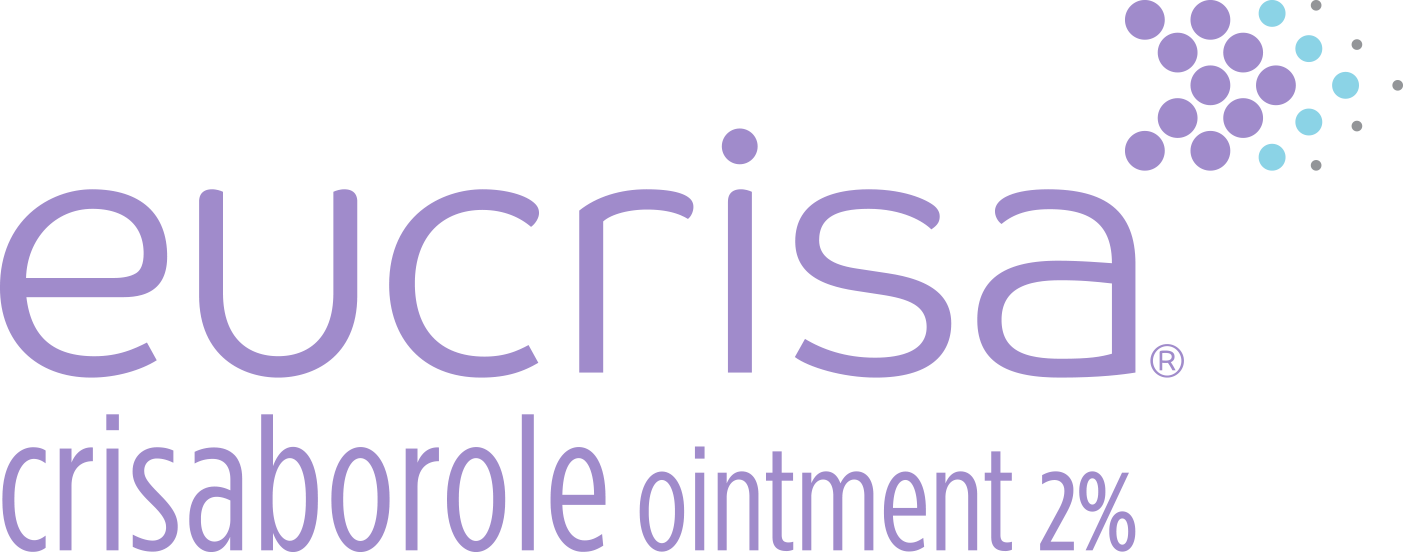Eczema often appears as a rough red rash on the face, arms, or legs, and can be accompanied by oozing, crusted bumps.
FAQ tabs
What are the signs and symptoms of atopic dermatitis (commonly known as eczema)?
What is EUCRISA?
EUCRISA (pronounced you-KRIS-a) is a steroid-free topical ointment approved to treat mild-to-moderate eczema in adults and children ages 3 months and up.
Some eczema treatments come in different strengths. Does EUCRISA come in different strengths?
EUCRISA is available in one dosage strength as a 2% ointment.
What are the ingredients in EUCRISA?
EUCRISA contains crisaborole (active ingredient) and the following inactive ingredients: white petrolatum, propylene glycol, mono- and di-glycerides, paraffin, butylated hydroxytoluene, and edetate calcium disodium.
EUCRISA does not contain added fragrance. It is also PABA-free, paraben-free, and gluten-free.
PABA=para-aminobenzoic acid.
How is EUCRISA supplied?
EUCRISA ointment is currently available in 60-g and 100-g tubes.
How does EUCRISA work?
EUCRISA is a topical ointment that works at and below the skin’s surface. It’s designed to block PDE4 enzymes within the skin. The specific way EUCRISA works is not well defined.
Where can I use EUCRISA?
EUCRISA is for use on skin (topical use) only. Do not use EUCRISA in your eyes, mouth, or vagina.
Who can use EUCRISA?
EUCRISA can be used by adults and children ages 3 months and up who have
What is the most common side effect of EUCRISA?
Some patients may experience burning or stinging where EUCRISA is applied. In our clinical trials of patients 2 years and older, 4% of EUCRISA and 1% of vehicle-treated patients experienced this side effect, and application site pain resolved within 1 day for 78% of those patients.
What important safety information should I know about EUCRISA?
Do not use EUCRISA if you are allergic to crisaborole or any of the ingredients in EUCRISA.
EUCRISA may cause side effects including allergic reactions at or near the application site or at a distant site. These can be serious and may include trouble breathing, throat or chest tightness, feeling faint, swelling of the face, eyelids, lips, mouth, tongue or throat, hives, itching, and redness. If you have any these symptoms, stop using EUCRISA and get medical help right away.
The most common side effect of EUCRISA is application site pain, such as burning or stinging.
EUCRISA is for use on skin (topical use) only. Do not use EUCRISA in your eyes, mouth, or vagina.
How should I use EUCRISA?
Always follow your doctor's instruction for use. It is recommended:
To treat flares: Apply a thin layer of EUCRISA to the affected areas 2 times each day.
If flares have improved: Your doctor may suggest reducing to once daily.
Wash your hands after applying, unless your hands are being treated. Do not use EUCRISA if you are allergic to crisaborole or any other ingredients in EUCRISA.
Should I stop moisturizing when using EUCRISA?
Talk to your healthcare professional if you have questions about moisturizing while using EUCRISA. Applying EUCRISA and moisturizers on the same location and at the same time was not studied in our clinical trials.
Where can I get EUCRISA?
You need a prescription to get EUCRISA. Talk to your healthcare professional if you have questions about getting EUCRISA.
Are there ways to get EUCRISA at a lower cost?
Yes! Pfizer Dermatology Patient Access is a savings and support program designed to help you in the following ways:
- savings offer on EUCRISA for eligible patients
- personalized insurance support to help you with your EUCRISA prescription
Is there a guide to help me prepare for my next doctor's visit?
Yes! You can download our Doctor Discussion Guide here, where you'll find tips to help you get the most out of your conversation with your doctor.

